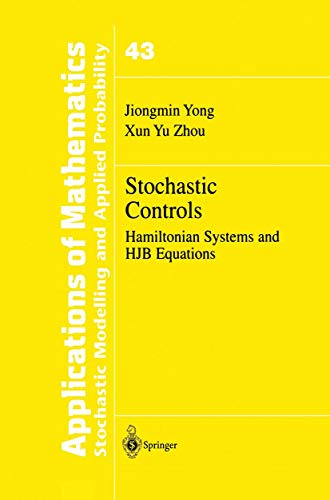Stochastic Controls: Hamiltonian Systems and HJB Equations (Stochastic Modelling and Applied Probability, 43) - Hardcover

Synopsis
As is well known, Pontryagin's maximum principle and Bellman's dynamic programming are the two principal and most commonly used approaches in solving stochastic optimal control problems. * An interesting phenomenon one can observe from the literature is that these two approaches have been developed separately and independently. Since both methods are used to investigate the same problems, a natural question one will ask is the fol lowing: (Q) What is the relationship betwccn the maximum principlc and dy namic programming in stochastic optimal controls? There did exist some researches (prior to the 1980s) on the relationship between these two. Nevertheless, the results usually werestated in heuristic terms and proved under rather restrictive assumptions, which were not satisfied in most cases. In the statement of a Pontryagin-type maximum principle there is an adjoint equation, which is an ordinary differential equation (ODE) in the (finite-dimensional) deterministic case and a stochastic differential equation (SDE) in the stochastic case. The system consisting of the adjoint equa tion, the original state equation, and the maximum condition is referred to as an (extended) Hamiltonian system. On the other hand, in Bellman's dynamic programming, there is a partial differential equation (PDE), of first order in the (finite-dimensional) deterministic case and of second or der in the stochastic case. This is known as a Hamilton-Jacobi-Bellman (HJB) equation.
"synopsis" may belong to another edition of this title.
About the Author
Jiongmin Yong is a professor at the Department of Mathematics, Fudan University, Shanghai, China.
"About this title" may belong to another edition of this title.
Other Popular Editions of the Same Title
Search results for Stochastic Controls: Hamiltonian Systems and HJB Equations...
Stochastic Controls: Hamiltonian Systems and Hjb Equations
Seller: Sizzler Texts, SAN GABRIEL, CA, U.S.A.
Soft cover. Condition: New. Dust Jacket Condition: New. 1st Edition. **INTERNATIONAL EDITION** Read carefully before purchase: This book is the international edition in mint condition with the different ISBN and book cover design, the major content is printed in full English as same as the original North American edition. The book printed in black and white, generally send in twenty-four hours after the order confirmed. All shipments go through via USPS/UPS/DHL with tracking numbers. Great professional textbook selling experience and expedite shipping service. Seller Inventory # ABE-10731546717
Stochastic Controls: Hamiltonian Systems and Hjb Equations
Seller: Aideo Books, San Marino, CA, U.S.A.
Trade paperback. Condition: New in new dust jacket. First edition. 1999 ed. ***INTERNATIONAL EDITION*** Read carefully before purchase: This book is the international edition in mint condition with the different ISBN and book cover design, the major content is printed in full English as same as the original North American edition. The book printed in black and white, generally send in twenty-four hours after the order confirmed. All shipments contain tracking numbers. Great professional textbook selling experience and expedite shipping service. Sewn binding. Cloth over boards. 464 p. Contains: Illustrations, black & white. Applications of Mathematics, 43. Audience: General/trade. Seller Inventory # K6030000462
Stochastic Controls : Hamiltonian Systems and Hjb Equations
Seller: GreatBookPrices, Columbia, MD, U.S.A.
Condition: New. Seller Inventory # 672760-n
Stochastic Controls: Hamiltonian Systems and HJB Equations (Stochastic Modelling and Applied Probability, 43)
Seller: Lucky's Textbooks, Dallas, TX, U.S.A.
Condition: New. Seller Inventory # ABLIING23Feb2215580175472
Stochastic Controls: Hamiltonian Systems and HJB Equations (Stochastic Modelling and Applied Probability, 43)
Seller: Ria Christie Collections, Uxbridge, United Kingdom
Condition: New. In English. Seller Inventory # ria9780387987231_new
Buy New
Quantity: Over 20 available
Stochastic Controls : Hamiltonian Systems and Hjb Equations
Seller: GreatBookPrices, Columbia, MD, U.S.A.
Condition: As New. Unread book in perfect condition. Seller Inventory # 672760
Stochastic Controls : Hamiltonian Systems and Hjb Equations
Seller: GreatBookPricesUK, Woodford Green, United Kingdom
Condition: New. Seller Inventory # 672760-n
Buy New
Quantity: Over 20 available
Stochastic Controls
Print on DemandSeller: moluna, Greven, Germany
Condition: New. Dieser Artikel ist ein Print on Demand Artikel und wird nach Ihrer Bestellung fuer Sie gedruckt. As is well known, Pontryagin s maximum principle and Bellman s dynamic programming are the two principal and most commonly used approaches in solving stochastic optimal control problems. * An interesting phenomenon one can observe from the literature is tha. Seller Inventory # 5913465
Buy New
Quantity: Over 20 available
Stochastic Controls
Seller: BuchWeltWeit Ludwig Meier e.K., Bergisch Gladbach, Germany
Buch. Condition: Neu. This item is printed on demand - it takes 3-4 days longer - Neuware -As is well known, Pontryagin's maximum principle and Bellman's dynamic programming are the two principal and most commonly used approaches in solving stochastic optimal control problems. \* An interesting phenomenon one can observe from the literature is that these two approaches have been developed separately and independently. Since both methods are used to investigate the same problems, a natural question one will ask is the fol lowing: (Q) What is the relationship betwccn the maximum principlc and dy namic programming in stochastic optimal controls There did exist some researches (prior to the 1980s) on the relationship between these two. Nevertheless, the results usually werestated in heuristic terms and proved under rather restrictive assumptions, which were not satisfied in most cases. In the statement of a Pontryagin-type maximum principle there is an adjoint equation, which is an ordinary differential equation (ODE) in the (finite-dimensional) deterministic case and a stochastic differential equation (SDE) in the stochastic case. The system consisting of the adjoint equa tion, the original state equation, and the maximum condition is referred to as an (extended) Hamiltonian system. On the other hand, in Bellman's dynamic programming, there is a partial differential equation (PDE), of first order in the (finite-dimensional) deterministic case and of second or der in the stochastic case. This is known as a Hamilton-Jacobi-Bellman (HJB) equation. 468 pp. Englisch. Seller Inventory # 9780387987231
Stochastic Controls : Hamiltonian Systems and Hjb Equations
Seller: GreatBookPricesUK, Woodford Green, United Kingdom
Condition: As New. Unread book in perfect condition. Seller Inventory # 672760
Buy Used
Quantity: Over 20 available


